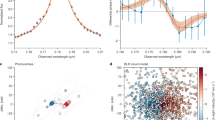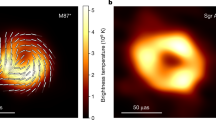Abstract
Tentative observations of shifted spectral lines in distant quasars1,2 have rekindled interest in Dirac's old idea3,4 that the fundamental 'constants' of physics may vary over time. Davies et al. have argued that black-hole thermodynamics favours theories in which the speed of light, c, decreases, and does not favour those in which the fundamental electronic charge, e, increases5. Here we show, however, that when the entire thermal environment of a black hole is considered, no such conclusion can be drawn. Although black-hole features such as mass quantization may still constrain models with varying 'constants'6, thermodynamics probably cannot.
Similar content being viewed by others
Main
The observations of refs 1, 2 suggest that the fine-structure constant, α, may have been slightly smaller in the early Universe. As α = e2/ℏc depends on e, c and Planck's constant, ℏ, it is natural to ask which of these values varies. Davies et al. offer an ingenious argument. A black hole with mass M and charge Q = ne has an entropy7 S = πG/ℏc[M + (M2 − n2e2/G)1/2]2. Evidently, an increase in e will reduce the entropy, violating the generalized second law of thermodynamics, whereas a decrease in ℏ or c will increase the entropy. This argument involves assumptions that may not be valid for all models6,8,9, but it offers an interesting starting point.
As Davies et al. note, however, such an argument should consider not just the black hole, but also its surroundings. An isolated black hole is never in thermal equilibrium: it decays by Hawking radiation and, if it is charged, by spontaneous emission of charged particles10. These processes reduce S, but do not violate the second law of thermodynamics because there is a compensating increase in the entropy of the environment.
To investigate the thermodynamics of varying 'constants', one should study a black hole that is in equilibrium with its environment. This can be done by considering a black hole in a 'box' of radius rB, with fixed boundary temperature T and charge Q (the canonical ensemble) or electrostatic potential φ (the grand canonical ensemble). Note that rB can be altered only by doing work on the system.
In the canonical ensemble, the entropy is given by S = πrB2x2, where x is determined by the seventh-order equation11 x5(x − q2)(x − 1) + b2(x2 − q2)2 = 0, where q = √√(GQ/rBc2) and b = ℏc/4πrBkT. Figure 1 shows a plot of S/rB2 against q2 and b. It is apparent — and may be confirmed numerically — that the entropy increases with increasing α. For the grand canonical ensemble, exact analytical results lead to the same conclusion. Black-hole thermodynamics thus militates against models in which the fundamental charge, e, decreases, but places no restriction on increasing e.
To compare this result with that of Davies et al., note first that the Hawking temperature of a charged black hole decreases with increasing e. A black hole will thus cool below the ambient temperature of the heat bath and will absorb heat, thereby increasing its mass. According to the first law of thermodynamics, the net change in entropy is dS = 1/T(dE − φ dQ), and it may be verified that the increase in the energy, E, dominates.
Of course, such thermodynamic arguments only describe relationships among equilibria, and not the transitions between equilibria. A more detailed analysis, however, requires an explicit, dynamic model. In particular, any theory with a variable fine-structure constant necessarily contains a new scalar field, α itself, the entropy of which cannot be neglected during dynamic processes in which α is changing. Jacobson (personal communication) has suggested that a suitable dynamic version of the second law of thermodynamics12 will ensure that entropy increases during such a process. Black-hole thermodynamics is therefore insufficient to constrain theories in which α increases.
References
Webb, J. K. et al. Phys. Rev. Lett. 82, 884–887 (1999).
Webb, J. K. et al. Phys. Rev. Lett. 87, 091301 (2001).
Dirac, P. A. M. Nature 139, 323 (1937).
Dirac, P. A. M. Proc. R. Soc. Lond. A 165, 199–208 (1938).
Davies, P. C. W., Davis, T. M. & Lineweaver, C. H. Nature 418, 602–603 (2002).
Carlip, S. Phys. Rev. D. 67, 023507 (2003).
Hawking, S. W. Commun. Math. Phys. 43, 199–220 (1975).
Flambaum, V. V. eprint astro-ph/0208384.
Barrow, J. D. eprint gr-qc/0211074.
Gibbons, G. W. Commun. Math. Phys. 44, 245–264 (1975).
Braden, H. W., Brown, J. D., Whiting, B. F. & York, J. W. Phys. Rev. D 42, 3376–3385 (1990).
Jacobson, T., Kang, G. & Myers, R. C. Phys. Rev. D 52, 3518–3528 (1995).
Author information
Authors and Affiliations
Corresponding author
Rights and permissions
About this article
Cite this article
Carlip, S., Vaidya, S. Do black holes constrain varying constants?. Nature 421, 498 (2003). https://doi.org/10.1038/421498a
Issue Date:
DOI: https://doi.org/10.1038/421498a
Comments
By submitting a comment you agree to abide by our Terms and Community Guidelines. If you find something abusive or that does not comply with our terms or guidelines please flag it as inappropriate.




